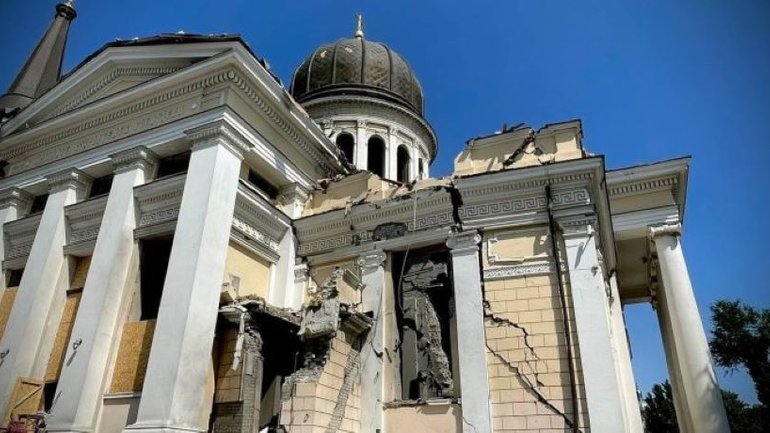War Destroying Ukraine's Cultural Heritage at Scale 'Not Seen Since WWII'

The first ground-based survey of Ukraine's historical landscape since Russia's full-scale invasion of the country in February 2022 has highlighted the true extent of the destruction caused by the ongoing war, which has been difficult to ascertain.
In addition to the tragic loss of life and the displacement of many Ukrainians, the conflict has resulted in thousands of cultural heritage sites—including many that were unrecorded—being damaged or destroyed.
Trying to understand how the war is decimating Ukrainian cultural heritage requires an assessment from the ground rather than using drones or satellites.
"As a group of international and Ukrainian archaeologists, we realized there was an urgent needed to visit these locations systematically and visit representative sites," Ian Kuijt, professor of anthropology with the University of Notre Dame who participated in the survey, told Newsweek. The study results have been published in the journal Antiquity.
The international team visited certain liberated areas—including around Kyiv and Chernihiv—to assess damage to selected cultural sites both above and below ground, making several findings.
Based on visits in March and October this year, the team found that the damage to Ukrainian cultural heritage is much more extensive than previously understood.
"Our research demonstrates that in liberated areas, such as Chernihiv, the Russians targeted cultural structures, including libraries and churches, and that many of these structures have either been destroyed or sustained major damage," Kuijt said.
This destruction also extends to cultural heritage below the ground, according to the study.
"Despite the modern military use of drones, tanks, and use of satellites, from a military standpoint, this war is based on trenches and bunkers," Kuijt said. "This involves digging in the earth, often on high points, and this has destroyed hundreds, if not thousands, of archaeology sites, such as medieval cemeteries and Bronze Age settlements."
The researcher highlighted two prominent examples of cultural heritage damage—the first being the partial destruction of a previously unknown graveyard around Oster, south of Chernihiv.
This "was a surprise and really illustrated for the first time that important, unknown, archaeology sites below the surface were being destroyed," Kuijt said. "The March visit, as well as later research in April, identified seven burials from the 11th century that had been destroyed."
Another example is the Church of the Ascension in Lukashivka. In this case, it was known that the brick church had lost part of its roof and windows, observed from satellites and laser scanning.
"But the shocking part was to walk into the church and realize the entire inside area had been subjected to a massive fire, and to walk around the inside of the building through shell casings, spent munitions, and remains from the battle," Kuijt said.
The researchers point out, however, that their assessment is limited to liberated areas around Kyiv and Chernihiv, where the rate of destruction has slowed, reduced to rare airstrikes. The study did not take into account the active war zones in eastern and southern Ukraine, where the level of destruction is likely to be significantly greater. The true scale of the damage in these areas could take years to determine after the war ends, according to Kuijt.
"In contrast, in active military areas of the east and south of Ukraine, the degree of destruction to cultural heritage has increased enormously," Kuijt said. "The construction of large trench systems and shelling is cutting through an unknown number of archaeological sites below the surface. Sadly, the process of mining and construction of entrenched fortifications along the front lines, and in depth from the front lines, is both destroying shocking amounts of human heritage."
The destruction of the country's cultural heritage has taken place at a scale that has not been since WWII, Kuijt said, although it is somewhat linked to geography.
"The urban areas of Kyiv look like a normal city in 2023, but some of the small villages further north around Chernihiv look like burned villages on the eastern front in 1944," he said. "If you consider the eastern and southern cities of Ukraine ... well, this is Berlin in March 1945 in terms of destruction. In the context of rural battleground in the east and south, this looks like WWI, with extensive trenches, etcetera."
There have been some efforts in Ukraine to protect and preserve the country's cultural heritage during the conflict. For example, when the full-scale invasion began, museums quickly moved most transportable displays and objects into protected locations, both because of the risk of looting by the Russians but also to protect the collections and objects in the case of shelling and missile strikes.
In the case of non-transportable cultural heritage, such as large church windows or public monuments, attempts have been made to protect them with sandbags, wood and metal. But much of the country's cultural heritage cannot be moved, and overall, very little has been done to protect it, according to Kuijt.
"Understandably and most importantly Ukrainians have been focused on protecting people, saving lives, and defending their country," he said.
The researchers are hoping that the latest results will help the international community understand the extent to which cultural heritage has been affected by the war.
"Second, we hope that this study will help the international community understand that there is an urgency in assessing the damage to Ukrainian cultural heritage and to develop discussion and debate as to how to mitigate ongoing destruction," Kuijt said.
"The prehistoric and post-medieval cultural heritage of Ukraine is a global heritage, for it links to Paleolithic hunter-gatherers who lived on the steppes, the development of Bronze Age villages with inhabitants that interacted with groups from around the Black Sea, the movement up the rivers of Vikings, and over a thousand years in which we witness the development of Christianity," he said.
"The heritage and history of Ukraine is important, is being targeted by the Russians, and needs to be protected."









